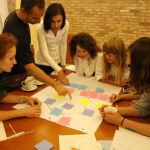System map
What is System map about ?
This method is based on a systems thinking approach to problems. It is particularly useful in the case of sustainability since dealing with modern global problems always involves complexity. Systemic approaches helps to see a bigger picture and understand the connections among environmental, social and economic aspects, creating the possibility to not compromise any of them while planning problem resolution.
Audience
Is participant experience relevant for System map ?
Requirements
Not specifically
Run Through
Depending on the size of the group you are working with you can divide the people into teams of 4-8 participants, 5 being the ideal number. Each group should have a comfortable table to sit around with a piece (or two pieces stuck together) of flipchart paper, post-its in a few colours, and markers in several colours. Pencils and an eraser might also be useful.
The main challenge
The causes
The causes of the causes
The effects
The effects of the effects
Harvest
Ask the teams to look at their maps and find the places in their system that could be the best for intervention - where the intervention could be effective, feasible and meaningful for the team. This is a good step to design the projects and solutions that help change the system and solve the problem.
Material for
-flipchart paper (minimum 2 pieces per team)
-colour markers (3 colours each group)
-colour post-its
-pencils
-eraser

ERASMUS +
Co-funded by the Erasmus+ Program of the European Union. Find more information about the program and its goals here: https://erasmus-plus.ec.europa.eu/.
Views and opinions expressed are however those of the author(s) only and do not necessarily reflect those of the European Union or the European Education and Culture Executive Agency (EACEA). Neither the European Union nor EACEA can be held responsible for them.

Creative Commons license:
CC-BY-SA You are free to distribute, remix, adapt, and build upon the material in any medium or format, even for commercial purposes with mention of the source: Transformation Hosts International, www. hostingtransformation.eu. If you remix, adapt, or build upon the material, you must license the modified material under identical terms.



